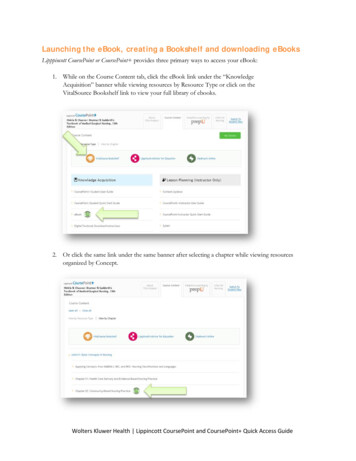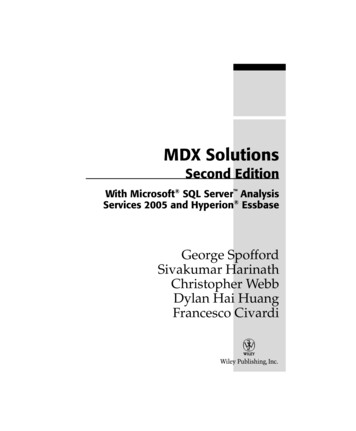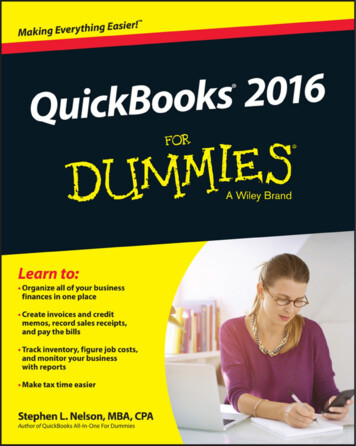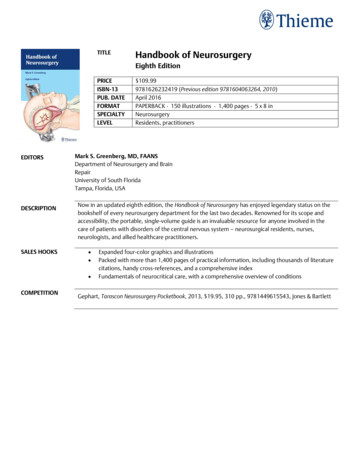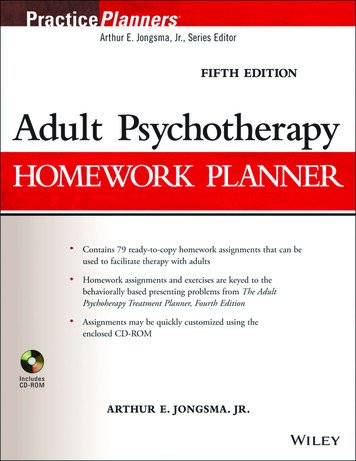
Transcription
Adult PsychotherapyHomework PlannerFifth Edition
PracticePlanners SeriesTreatment PlannersThe Complete Adult Psychotherapy Treatment Planner, Fifth EditionThe Child Psychotherapy Treatment Planner, Fifth EditionThe Adolescent Psychotherapy Treatment Planner, Fifth EditionThe Addiction Treatment Planner, Fifth EditionThe Continuum of Care Treatment PlannerThe Couples Psychotherapy Treatment Planner, Second EditionThe Employee Assistance Treatment PlannerThe Pastoral Counseling Treatment PlannerThe Older Adult Psychotherapy Treatment Planner, Second EditionThe Behavioral Medicine Treatment PlannerThe Group Therapy Treatment PlannerThe Gay and Lesbian Psychotherapy Treatment PlannerThe Family Therapy Treatment Planner, Second EditionThe Severe and Persistent Mental Illness Treatment Planner, Second EditionThe Mental Retardation and Developmental Disability Treatment PlannerThe Social Work and Human Services Treatment PlannerThe Crisis Counseling and Traumatic Events Treatments Planner, Second EditionThe Personality Disorders Treatment PlannerThe Rehabilitation Psychology Treatment PlannerThe Special Education Treatment PlannerThe Juvenile Justice and Residential Care Treatment PlannerThe School Counseling and School Social Work Treatment Planner, Second EditionThe Sexual Abuse Victim and Sexual Offender Treatment PlannerThe Probation and Parole Treatment PlannerThe Psychopharmacology Treatment PlannerThe Speech-Language Pathology Treatment PlannerThe Suicide and Homicide Treatment PlannerThe College Student Counseling Treatment PlannerThe Parenting Skills Treatment PlannerThe Early Childhood Intervention Treatment PlannerThe Co-Occurring Disorders Treatment PlannerThe Complete Women’s Psychotherapy Treatment PlannerThe Veterans and Active Duty Military Psychotherapy Treatment PlannerProgress Notes PlannersThe Child Psychotherapy Progress Notes Planner, Fifth EditionThe Adolescent Psychotherapy Progress Notes Planner, Fifth EditionThe Adult Psychotherapy Progress Notes Planner, Fifth EditionThe Addiction Progress Notes Planner, Fifth EditionThe Severe and Persistent Mental Illness Progress Notes Planner, Second EditionThe Couples Psychotherapy Progress Notes Planner, Second EditionThe Family Therapy Progress Notes Planner, Second EditionThe Veterans and Active Duty Military Psychotherapy Progress Notes PlannerHomework PlannersCouples Therapy Homework Planner, Second EditionFamily Therapy Homework Planner, Second EditionGrief Counseling Homework PlannerGroup Therapy Homework PlannerDivorce Counseling Homework PlannerSchool Counseling and School Social Work Homework Planner, Second EditionChild Therapy Activity and Homework PlannerAddiction Treatment Homework Planner, Fifth EditionAdolescent Psychotherapy Homework Planner, Fifth EditionAdult Psychotherapy Homework Planner, Fifth EditionChild Psychotherapy Homework Planner, Fifth EditionParenting Skills Homework PlannerVeterans and Active Duty Military Psychotherapy Homework PlannerClient Education Handout PlannersAdult Client Education Handout PlannerChild and Adolescent Client Education Handout PlannerCouples and Family Client Education Handout PlannerComplete PlannersThe Complete Depression Treatment and Homework PlannerThe Complete Anxiety Treatment and Homework Planner
PracticePlanners Adult PsychotherapyHomework PlannerFifth EditionArthur E. Jongsma, Jr.
Cover image: Ryan McVay/Getty ImagesCover design: WileyThis book is printed on acid-free paper.Copyright 2014 by Arthur E. Jongsma, Jr. All rights reserved.Published by John Wiley & Sons, Inc., Hoboken, New JerseyPublished simultaneously in CanadaNo part of this publication may be reproduced, stored in a retrieval system, or transmitted in any form or byany means, electronic, mechanical, photocopying, recording, scanning, or otherwise, except as permitted underSection 107 or 108 of the 1976 United States Copyright Act, without either the prior written permission of thePublisher, or authorization through payment of the appropriate per-copy fee to the Copyright Clearance Center,222 Rosewood Drive, Danvers, MA 01923, (978) 750-8400, fax (978) 646-8600, or on the web atwww.copyright.com. Requests to the Publisher for permission should be addressed to the PermissionsDepartment, John Wiley & Sons, Inc., 111 River Street, Hoboken, NJ 07030, (201) 748-6011, fax (201) 748-6008,or online at www.wiley.com/go/permissions.Limit of Liability/Disclaimer of Warranty: While the publisher and author have used their best efforts inpreparing this book, they make no representations or warranties with the respect to the accuracy orcompleteness of the contents of this book and specifically disclaim any implied warranties of merchantability orfitness for a particular purpose. No warranty may be created or extended by sales representatives or writtensales materials. The advice and strategies contained herein may not be suitable for your situation. You shouldconsult with a professional where appropriate. Neither the publisher nor the author shall be liable for damagesarising herefrom.For general information about our other products and services, please contact our Customer Care Departmentwithin the United States at (800) 762-2974, outside the United States at (317) 572-3993 or fax (317) 572-4002.Wiley publishes in a variety of print and electronic formats and by print-on-demand. Some material includedwith standard print versions of this book may not be included in e-books or in print-on-demand. If this bookrefers to media such as a CD or DVD that is not included in the version you purchased, you may download thismaterial at http://booksupport.wiley.com. For more information about Wiley products, visit www.wiley.com.Library of Congress Cataloging-in-Publication Data:Jongsma, Arthur E., Jr., 1943–Adult psychotherapy homework planner / Arthur E. Jongsma, Jr.—Fifth edition.pages cmIncludes index.ISBN 978-1-118-07672-9 (pbk.)ISBN 978-1-118-83625-5 (ebk.)ISBN 978-1-118-83637-8 (ebk.)1. Psychotherapy–Planning–Handbooks, manuals, etc. 2. Psychotherapy–Problems, exercises, etc. I. Title.RC480.5.J664 2014616.89'14—dc232013027950Printed in the United States of America10 9 8 7 6 5 4 3 2 1
To Dave and Lorrie Vander Ark,whose friendship has enriched our lives andwhose support is more reliable than a fine timepiece
CONTENTSPracticePlanners Series PrefaceAcknowledgmentsxvxviiIntroduction1SECTION 1: Anger Control Problems4Exercise 1.AAlternatives to Destructive Anger5Exercise 1.BAnger Journal9Exercise 1.CAssertive Communication of AngerSECTION 2: Antisocial Behavior1215Exercise 2.AHow I Have Hurt Others16Exercise 2.BLetter of Apology19Exercise 2.CThree Acts of Kindness21SECTION 3: Anxiety22Exercise 3.AAnalyze the Probability of a Feared Event23Exercise 3.BExercise 3.CPast Successful Anxiety CopingWorry Time2629SECTION 4: Attention Deficit Disorder (ADD)—AdultExercise 4.AProblem-Solving: An Alternative to Impulsive ActionExercise 4.BSelf-Monitoring/Self-Reward ProgramExercise 4.CSymptoms and Fixes for ADD31323640SECTION 5: Bipolar—DepressionExercise 5.AEarly Warning Signs of DepressionExercise 5.BIdentifying and Handling Triggers434447SECTION 6: Bipolar—ManiaExercise 6.AKeeping a Daily RhythmExercise 6.BRecognizing the Negative Consequences of ImpulsiveBehavior515359ix
xCONTENTSExercise 6.CWhat Are My Good Qualities?63Exercise 6.DWhy I Dislike Taking My Medication67SECTION 7: Borderline Personality69Exercise 7.AJournal and Replace Self-Defeating Thoughts70Exercise 7.BPlan Before Acting77SECTION 8: Childhood Trauma79Exercise 8.AChanging From Victim to Survivor80Exercise 8.BDeep Breathing Exercise84Exercise 8.CFeelings and Forgiveness Letter87SECTION 9: Chronic PainExercise 9.APain and Stress JournalSECTION 10: Cognitive Deficits909193Exercise 10.AMemory Aid—Personal Information Organizer94Exercise 10.BMemory Enhancement Techniques99SECTION 11: Dependency102Exercise 11.AMaking Your Own Decisions103Exercise 11.BSatisfying Unmet Emotional Needs105Exercise 11.CTaking Steps Toward Independence109SECTION 12: Dissociation111Exercise 12.ADescribe the Trauma112Exercise 12.BStaying Focused on the Present Reality115SECTION 13: Eating Disorders and Obesity117Exercise 13.AA Reality Journal: Food, Weight, Thoughts, and Feelings118Exercise 13.BHow Fears Control My Eating125SECTION 14: Educational Deficits128Exercise 14.AMy Academic and Vocational Strengths129Exercise 14.BThe Advantages of Education132
CONTENTSSECTION 15: Family Conflictxi134Exercise 15.AApplying Problem Solving to Interpersonal Conflict135Exercise 15.BA Structured Parenting Plan138SECTION 16: Female Sexual Dysfunction141Exercise 16.AFactors Influencing Negative Sexual Attitudes142Exercise 16.BStudy Your Body: Clothed and Unclothed146SECTION 17: Financial StressExercise 17.APlan a BudgetSECTION 18: Grief/Loss Unresolved149150153Exercise 18.ACreating a Memorial Collage154Exercise 18.BDear : A Letter to a Lost Loved One157SECTION 19: Impulse Control DisorderExercise 19.AImpulsive Behavior JournalSECTION 20: Intimate Relationship Conflicts160161164Exercise 20.AHow Can We Meet Each Other’s Needs and Desires?165Exercise 20.BPositive and Negative Contributions to theRelationship: Mine and Yours170SECTION 21: Legal Conflicts172Exercise 21.AAccept Responsibility for Illegal Behavior173Exercise 21.BCrooked Thinking Leads to Crooked Behavior176SECTION 22: Low Self-Esteem178Exercise 22.AAcknowledging My Strengths179Exercise 22.BReplacing Fears With Positive Messages182SECTION 23: Male Sexual DysfunctionExercise 23.AJournaling the Response to Nondemand, SexualPleasuring (Sensate Focus)SECTION 24: Medical Issues185186191Exercise 24.AHow I Feel About My Medical Treatment192Exercise 24.BThe Impact of My Illness195
xiiCONTENTSSECTION 25: Obsessive-Compulsive Disorder (OCD)197Exercise 25.AInterrupting Your Obsessions/Compulsions198Exercise 25.BMaking Use of the Thought-Stopping Technique202Exercise 25.CReducing the Strength of Compulsive Behaviors206SECTION 26: Panic/Agoraphobia210Exercise 26.ACoping Card211Exercise 26.BMonitoring My Panic Attack Experiences214SECTION 27: Paranoid IdeationExercise 27.ACheck Suspicions Against RealitySECTION 28: Parenting216217219Exercise 28.ALearning to Parent as a Team220Exercise 28.BThe Two Sides of Parenting224Exercise 28.CUsing Reinforcement Principles in Parenting228SECTION 29: Phase of Life Problems231Exercise 29.AWhat Needs to Be Changed in My Life?232Exercise 29.BWhat’s Good About Me and My Life?235SECTION 30: Phobia237Exercise 30.AFour Ways to Reduce Fear238Exercise 30.BGradually Reducing Your Phobic Fear242SECTION 31: Posttraumatic Stress Disorder (PTSD)245Exercise 31.AHow the Trauma Affects Me246Exercise 31.BShare the Painful Memory249SECTION 32: PsychoticismExercise 32.AWhat Do You Hear and See?SECTION 33: Sexual Abuse Victim252253255Exercise 33.AA Blaming Letter and a Forgiving Letter to Perpetrator256Exercise 33.BPicturing the Place of the Abuse259
CONTENTSSECTION 34: Sexual Identity Confusionxiii261Exercise 34.AJournal of Sexual Thoughts, Fantasies, Conflicts262Exercise 34.BTo Whom and How to Reveal My Homosexuality269SECTION 35: Sleep DisturbanceExercise 35.ASleep Pattern RecordSECTION 36: Social Anxiety272273276Exercise 36.ABecoming Assertive277Exercise 36.BRestoring Socialization Comfort281SECTION 37: SomatizationExercise 37.AControlling the Focus on Physical ProblemsSECTION 38: Spiritual Confusion283284287Exercise 38.AMy History of Spirituality288Exercise 38.BYour Spiritual Inheritance Inventory291SECTION 39: Substance Use295Exercise 39.AAftercare Plan Components296Exercise 39.BIdentifying Relapse Triggers and Cues300Exercise 39.CRelapse Prevention Planning305Exercise 39.DRelapse Triggers309Exercise 39.ESubstance Abuse’s Negative Impact Versus Sobriety’sPositive Impact312SECTION 40: Suicidal Ideation316Exercise 40.AJournal of Distorted, Negative Thoughts317Exercise 40.BNo Self-Harm Contract321Exercise 40.CStrategies to Resist Suicidal Thoughts and Feelings324Exercise 40.DThe Aftermath of Suicide327SECTION 41: Type A BehaviorExercise 41.ADeveloping Noncompetitive Values330331
xivCONTENTSSECTION 42: Unipolar Depression333Exercise 42.AIdentify and Schedule Pleasant Activities334Exercise 42.BNegative Thoughts Trigger Negative Feelings337Exercise 42.CPositive Self-Talk342SECTION 43: Vocational StressExercise 43.AA Vocational Action Plan344345Appendix A: Alternate Assignments for Presenting Problems347Appendix B: Alphabetical Index of Exercises358About the CD-ROM361
PRACTICEPLANNERS SERIES PREFACEAccountability is an important dimension of the practice of psychotherapy. Treatmentprograms, public agencies, clinics, and practitioners must justify and document theirtreatment plans to outside review entities in order to be reimbursed for services. Thebooks and software in the PracticePlanners series are designed to help practitionersfulfill these documentation requirements efficiently and professionally.The PracticePlanners series includes a wide array of treatment planning books including not only the original Complete Adult Psychotherapy Treatment Planner, ChildPsychotherapy Treatment Planner, and Adolescent Psychotherapy Treatment Planner,all now in their fifth editions, but also Treatment Planners targeted to specialty areas ofpractice, including: AddictionsCo-occurring disordersBehavioral medicineCollege studentsCouples therapyCrisis counselingEarly childhood educationEmployee assistanceFamily therapyGays and lesbiansGroup therapyJuvenile justice and residential careMental retardation and developmental disabilityNeuropsychologyOlder adultsParenting skillsPastoral counselingPersonality disordersProbation and parolePsychopharmacologyRehabilitation psychologySchool counseling and school social workSevere and persistent mental illnessSexual abuse victims and offendersSocial work and human servicesSpecial educationxv
xviPRACTICEPLANNERS SERIES PREFACE Speech-Language pathologySuicide and homicide risk assessmentVeterans and active duty militaryWomen’s issuesIn addition, there are three branches of companion books that can be used in conjunction with the Treatment Planners, or on their own: Progress Notes Planners provide a menu of progress statements that elaborateon the client’s symptom presentation and the provider’s therapeutic intervention.Each Progress Notes Planner statement is directly integrated with the behavioraldefinitions and therapeutic interventions from its companion Treatment Planner. Homework Planners include homework assignments designed around eachpresenting problem (such as anxiety, depression, substance use, anger controlproblems, eating disorders, or panic disorder) that is the focus of a chapter in itscorresponding Treatment Planner. Client Education Handout Planners provide brochures and handouts to helpeducate and inform clients on presenting problems and mental health issues, aswell as life skills techniques. The handouts are included on CD-ROMs for easyprinting from your computer and are ideal for use in waiting rooms, in presentations, as newsletters, or as information for clients struggling with mental illnessissues. The topics covered by these handouts correspond to the presenting problems in the Treatment Planners.Adjunctive books, such as The Psychotherapy Documentation Primer and The ClinicalDocumentation Sourcebook, contain forms and resources to aid the clinician in mentalhealth practice management.The goal of our series is to provide practitioners with the resources they need in order to provide high quality care in the era of accountability. To put it simply: We seek tohelp you spend more time on patients, and less time on paperwork.ARTHUR E. JONGSMA, JR.Grand Rapids, Michigan
ACKNOWLEDGMENTSAlthough only my name appears as the author of this book, the product is the result ofthe combined efforts of many people. I first would like to acknowledge the contributionof my coauthors on several other books, William McInnis and Mark Peterson. Theyassisted heavily in the rewrite of this edition of the Adult Psychotherapy HomeworkPlanner. They also both previously gave permission for me to borrow and adapt some ofthe homework exercises we had collaborated on in writing the AdolescentPsychotherapy Homework Planner. Several of the assignments in this book have beenadapted to the adult focus group from their original creation for the adolescent client.Thank you, Bill and Mark.I would also like to thank Jim Finley and Brenda Lenz for giving their permission tome to adapt two of their assignments from their Addiction Treatment HomeworkPlanner for placement in the Substance Use section of this book.I am grateful to Sue Rhoda, who was so efficient at transcribing this manuscript in avery timely and professional manner.My support staff at John Wiley & Sons, Marquita Flemming, Peggy Alexander, SwetaGupta, and Judi Knott, continues to move the PracticePlanners project forward withenthusiasm and professional dedication. Thank you, all.Finally, my personal support system is grounded in my wife, Judy, who makes me feelimportant even when I am not, and my children and grandchildren, who consistentlyshow interest in my work. Thank you, family.A. E. J.xvii
INTRODUCTIONMore and more therapists are assigning homework to their clients. Not only have shortterm therapy models endorsed this practice, but the benefits are being recognized bymany traditional therapists as well.WHY HOMEWORK?Assigning homework to psychotherapy clients is beneficial for several reasons. With theadvent of managed care, which often requires shorter and fewer treatment sessions,therapists assign between-session homework to help maximize the effectiveness ofbriefer treatment. Homework is an extension of the treatment process, providescontinuity, and allows the client to work between sessions on issues that are the focusof therapy. Homework is also a tool for more fully engaging the client in the treatmentprocess. Assignments place more responsibility on the client to resolve his or herpresenting problems, counteracting the expectations that some clients mayexperience—that it is the therapist alone who can cure him or her. For some, it evenmay bring a sense of self-empowerment.Another added benefit of homework is that these assignments give the client theopportunity to implement and evaluate insights or coping behaviors that have beendiscussed in therapy sessions. Practice often heightens awareness of various issues.Furthermore, homework increases the expectation for the client to follow through withmaking changes rather than just talking about change. Exercises require participation,which creates a sense that the client is taking active steps toward change. Homeworkallows the client to try new behaviors, bringing these experiences back to the nextsession for processing. Modifications can then be made to the client’s thoughts, feelings,or behaviors as the homework is processed in the therapy session.Occasionally treatment processes can become vague and abstract. By adding focusand structure, homework assignments can reenergize treatment. Moreover, homeworkcan increase the client’s motivation to change as it provides something specific to workon. Additionally, homework increases the involvement of family members andsignificant others in the client’s treatment by using assignments that call for theirparticipation. It promotes more efficient treatment by encouraging the client to activelydevelop insights, positive self-talk, and coping behaviors between therapy sessions.Consequently, many clients express increased satisfaction with the treatment processwhen homework is given. They are empowered by doing something active thatfacilitates the change process, and it reinforces their sense of control over the problem.All of these advantages have made the assignment of therapeutic homeworkincreasingly prevalent.INTRODUCTION 1
HOW TO USE THIS HOMEWORK PLANNERCreating homework assignments and developing the printed forms for recordingresponses is a time-consuming process. This Adult Psychotherapy Homework Planner,Fifth Edition, follows the lead of psychotherapeutic interventions suggested in TheComplete Adult Psychotherapy Treatment Planner, Fifth Edition (Jongsma, Peterson,and Bruce, 2014) and provides a menu of homework assignments that can easily bephotocopied. In addition to the printed format, the assignments in this Planner areprovided on a CD-ROM to allow the therapist to access them on a word processor andprint them out as is or easily customize them to suit the client’s individual needs and/orthe therapist’s style.The assignments are grouped under presenting problems that are typical of thosefound in an adult population. These presenting problems are cross-referenced to everypresenting problem found in The Complete Adult Psychotherapy Treatment Planner. Although these assignments were created with a specific presenting problem in mind,don’t feel locked in by a single problem-oriented chapter when searching for anappropriate assignment. Included with each exercise is a cross-referenced list ofsuggested presenting problems for which the assignment may be appropriate anduseful called Additional Problems for Which This Exercise May Be Most Useful. Thiscross-referenced list can assist you in applying the assignments to other situations thatmay be relevant to your client’s particular presenting problem.A broader cross-referenced list of assignments is found in Appendix A, Alternate Assignments for Presenting Problems. Review this appendix to find relevant assignmentsbeyond the one, two, three, or four exercises found in any specific presenting problemchapter. For example, under the heading of Unipolar Depression in the appendix youwill find 27 alternative assignments originally created for other presenting problemsbut relevant and easily adapted for use with a client struggling with depression issues.In this appendix, with every presenting problem are listed relevant additionalassignments from throughout the book. Remember, each assignment is available on theCD-ROM at the back of the book and, therefore, can be quickly edited for use with aspecific client. This modified assignment can be saved on your computer’s hard disk forrepeated later use.ABOUT THE ASSIGNMENTSTherapists may introduce the homework assignment with varying degrees of detail andclient preparation. Recommendations regarding this preparation and post-exercisediscussion are made on the title page of each assignment under the heading“Suggestions for Processing This Exercise with the Client.”Clinical judgment must be used to choose the homework assignments that focus onrelevant issues for the client. The title page of each assignment contains a section on“Goals of the Exercise” to guide you in your selection of relevant homework for your client.2 INTRODUCTION
CARRYING OUT THE ASSIGNMENTIt is recommended that you review the entire book to familiarize yourself with thebroad nature of the type and focus of the various homework exercises. Select a specificassignment from a chapter titled with your client’s presenting problem or from thealternative list in the appendix and then review the list of homework goals. Assigningtherapy homework is just a beginning step in the therapy treatment process. Carryingout the assignment requires a follow-up exploration of the impact of the assignment onthe client’s thoughts, feelings, and behavior. What are the results? Was this assignmentuseful to the client? Can it be redesigned or altered for better results? Examine andsearch for new and creative ways to actively engage your client in participating in thishomework process.INTRODUCTION 3
SECTION 1: ANGER CONTROL PROBLEMSTherapist’s OverviewALTERNATIVES TO DESTRUCTIVE ANGERGOALS OF THE EXERCISE1.2.3.Increase awareness of how anger is expressed destructively.Decrease the number, intensity, and duration of angry outbursts while increasingthe use of new skills for managing anger.Become capable of handling angry feelings in constructive ways that enhance dailyfunctioning.ADDITIONAL PROBLEMS FOR WHICH THIS EXERCISE MAY BE MOST USEFUL Antisocial BehaviorAttention Deficit Disorder (ADD)—AdultBorderline PersonalityFamily ConflictPosttraumatic Stress Disorder (PTSD)SUGGESTIONS FOR PROCESSING THIS EXERCISE WITH THE CLIENTClients often feel they responded to a frustrating situation in the only way possible.They fail to realize that they have choices and control over their behavior. You maywant to review the alternatives to rage listed in the first section of the assignment tohelp the client understand the alternatives he/she could apply when dealing withfrustration or anger. Review the client’s journal material and suggest additionalconstructive ways to respond to frustrating or hurtful situations that prompt his/hermismanaged anger.4 ANGER CONTROL PROBLEMS
EXERCISE 1.AALTERNATIVES TO DESTRUCTIVE ANGERDestructive anger can take many forms. Anger can be expressed in rage that is out ofcontrol, either verbally or physically. We also can express anger by snapping atsomeone or being unkindly critical. A third form that anger may take is that of cold, icywithdrawal that punishes others by shutting them out, shunning them, or refusing toacknowledge their attempts to relate to us. All of these reactions and many more can bedestructive to the relationship and to our own feelings of self-esteem. Destructiveexpressions of anger often generate later feelings of guilt and shame.This exercise is designed to briefly identify some constructive alternatives todestructive anger by giving a brief description of the positive alternative. The goal is foryou to consider these alternatives as you seek to replace destructive anger with moreconstructive behaviors. You will be asked to keep a journal of situations in your dailylife that provoked anger and then note how one or more of these constructivealternatives may have been applied to the situations.CONSTRUCTIVE ALTERNATIVESA.Assertiveness: Speaking forthrightly in a manner that is very respectful of the otherperson’s needs and rights and does not attack anyone so as to make him/herdefensive.B.Tune Out/Cool Down: Recognize that the situation has become volatile andnonproductive and suggest withdrawal from the situation to give each party achance to cool down and collect his/her thoughts and regain personal control.C.Relaxation: Learn and implement relaxation skills to reduce stress and tensionthrough the use of words that cue relaxation, deep breathing that releases tension,imagining relaxing scenes, or deep muscle relaxation procedures.D.Diversion: When anger is felt to be building, find diversionary activities that stopthe buildup and focus the mind on more enjoyable experiences.E.Physical Exercise: When anger and tension levels rise, physical exercise can be awonderful way to release tension and expel energy as an alternative to losingcontrol or exploding in rage.F.Problem-Solving Skills: Identify or clarify the problem, brainstorm possiblesolutions, review the pros and cons of each alternative solution, select the bestalternative for implementation, evaluate the outcome as to mutual satisfaction,and finally, adjust the solution if necessary to increase mutual satisfaction.ANGER CONTROL PROBLEMS 5
EXERCISE 1.AG.Self-Talk: Take time to talk to yourself in calming, reasoned, and constructivesentences that move you toward anger control and away from hurtful expressionsof anger.H. “I” Messages: Speak to the target of your anger, describing your feelings and needsrather than attacking, labeling, or describing the other person’s behavior,motivations, or goals. Begin your sentences with “I feel . . .” or “I need . . . .”I.Other: Describe your own or your counselor’s alternative to rage.APPLICATION TO DAILY LIFEIn the columns that follow, describe the date and time, the situation that prompted theangry response, the destructive response, and the alternative constructive responsethat might have been used. In the final row, instead of writing a full description of thealternative, you may simply enter the alphabetical indicator of the constructivealternative, A through I.Entry 1SituationDay/Dateand Time:ResponseAlternativeResponse(NOTE: Please make additional copies of the next page for later entries.)6 ANGER CONTROL PROBLEMS
EXERCISE 1.AEntrySituation(# of entry)Day/Dateand Time:ResponseAlternativeResponseEntrySituation(# of entry)Day/Dateand Time:ResponseAlternativeResponseANGER CONTROL PROBLEMS 7
Therapist’s OverviewANGER JOURNALGOALS OF THE EXERCISE1.2.3.Develop an awareness of current angry behaviors, clarifying origins of andalternatives to aggressive anger.Keep a daily journal of persons, situations, and other triggers of anger; recordthoughts, feelings, and actions taken.Decrease the number, intensity, and duration of angry outbursts while increasingthe use of new skills for managing anger.ADDITIONAL PROBLEMS FOR WHICH THIS EXERCISE MAY BE MOST USEFUL Antisocial BehaviorBorderline PersonalityFamily ConflictPosttraumatic Stress Disorder (PTSD)SUGGESTIONS FOR PROCESSING THIS EXERCISE WITH THE CLIENTSome clients deny the degree of anger they feel and express. Other clients may beaware of feelings of anger but need help in understanding the contributing factors andcauses for their anger. As you process the journal entries with clients, help them clarifyand pinpoint these contributing factors and the causes for their anger. Often the causesfor the anger are not those that are initially identified, but lie beneath the surface andcan be discovered with some patient processing. Finally, it is helpful to press the clienttoward describing positive alternative behaviors that could have replaced themaladaptive anger responses that were selected in the heat of the moment. Positivealternatives may include things like assertiveness, time-out, problem solving, “I”messages, or self-talk.8ANGER CONTROL PROBLEMS pag
The Child Psychotherapy Progress Notes Planner, Fifth Edition The Adolescent Psychotherapy Progress Notes Planner, Fifth Edition The Adult Psychotherapy Progress Notes Planner, Fifth Edition The Addiction Progress Notes Planner, Fifth Edition The Severe and Persistent Mental Illness Progres
